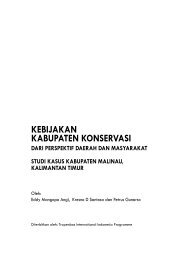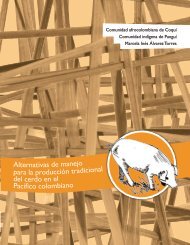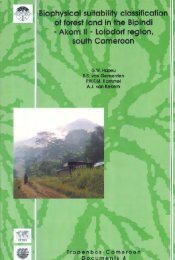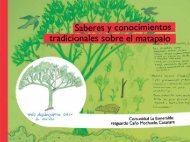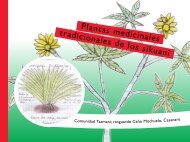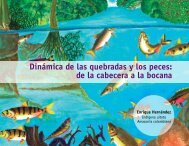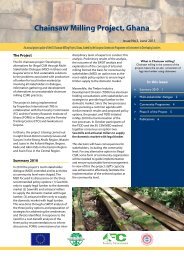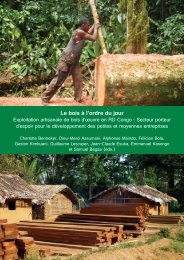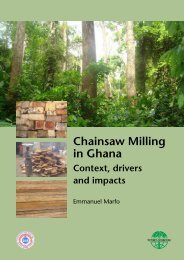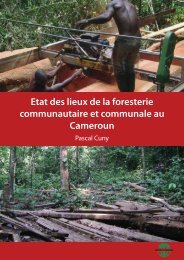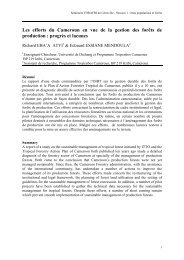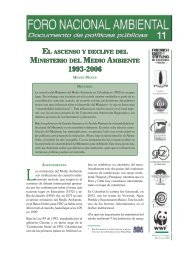Download the publication - Tropenbos International
Download the publication - Tropenbos International
Download the publication - Tropenbos International
Create successful ePaper yourself
Turn your PDF publications into a flip-book with our unique Google optimized e-Paper software.
Bio-indicator species and Central African rain forest refuges<br />
contributed to modify <strong>the</strong> balance of present-day ecological factors influencing <strong>the</strong><br />
succession processes of <strong>the</strong>se forests. We may <strong>the</strong>refore predict that if <strong>the</strong> current<br />
human perturbation is maintained <strong>the</strong> lowland rain forest rich in Calpocalyx heitzii<br />
and Sacoglottis gabonensis will fur<strong>the</strong>r expand into <strong>the</strong> evergreen forest rich in<br />
Caesalpinioideae. But if <strong>the</strong> ongoing human pressure is controlled, we will ra<strong>the</strong>r<br />
expect a progressive expansion of <strong>the</strong> Caesalpinioideae forest towards <strong>the</strong> coast. In<br />
<strong>the</strong> drier Ma’an area, we will also expect to have more patches of evergreen<br />
Caesalpinioideae forest within <strong>the</strong> mixed evergreen and semi-deciduous forest.<br />
However, it should be mentioned that we expect a ra<strong>the</strong>r slow expansion of<br />
evergreen rain forest because it may not be able to cope with <strong>the</strong> relatively low<br />
precipitation recorded in <strong>the</strong> Ma’an area (below 1700 mm/year). Taking into<br />
consideration <strong>the</strong> fact that <strong>the</strong> Ma’an area is located within a transitional climatic<br />
zone with a relatively low annual rainfall, its vegetation represents a transition<br />
between <strong>the</strong> dry deciduous forest and <strong>the</strong> wet evergreen lowland forest rich in<br />
Caesalpinioideae.<br />
The Campo-Ma’an rain forest, with its high concentration of endemic species and<br />
rich forest species diversity, is probably part of a late Pleistocene refuge as<br />
postulated in south-western Cameroon by several authors (Aubreville, 1962; White,<br />
1979 & 1983, Maley, 1987, 1989 & 1990; Sosef, 1994). We assume that this refuge<br />
may probably extend fur<strong>the</strong>r north-east along <strong>the</strong> mountainous range that goes up to<br />
<strong>the</strong> Bipindi area, because many narrow endemic species were also known to occur in<br />
<strong>the</strong> Akom II-Bipindi-Lolodorf areas. Overall, <strong>the</strong> distribution maps of <strong>the</strong> various<br />
bio-indicator species showed a low concentration of <strong>the</strong>se species in <strong>the</strong> mixed<br />
evergreen and semi-deciduous forest located in <strong>the</strong> drier Nyabissan-Ma’an-Mekok<br />
area. A similar pattern was also observed from <strong>the</strong> distribution of strict and narrow<br />
endemic species. As shown in Table 4.2, only 15% of <strong>the</strong> total number of strict and<br />
narrow endemics and 46% of <strong>the</strong> selected bio-indicator species were recorded in this<br />
area. Fur<strong>the</strong>rmore, <strong>the</strong> drier Ma’an area is characterised by a semi-deciduous forest<br />
type with discontinuous canopy and <strong>the</strong> presence of many fully grown secondary<br />
forest species. This may suggest that <strong>the</strong> Ma’an area might have suffered from past<br />
human disturbance or that it may have been colonised by an open vegetation type<br />
during <strong>the</strong> dry-out periods. Therefore, it is probably undergoing a phase of forest<br />
recolonisation under <strong>the</strong> present climatic conditions. Taking into consideration <strong>the</strong><br />
fact that <strong>the</strong> Ma’an vegetation shows a strong secondary character in terms of its<br />
species composition with many semi-deciduous elements, we can hypo<strong>the</strong>sise that it<br />
was not part of <strong>the</strong> postulated forest refuge in south-western Cameroon under<br />
substantial drier atmospheric conditions than today.<br />
It should be noted that <strong>the</strong>se patterns in species richness are also <strong>the</strong> result of past<br />
and present biotic and abiotic structuring processes as has been clearly shown in<br />
Chapter 2. Taking into consideration <strong>the</strong> fact that paleo-evidence provides more<br />
information leading to <strong>the</strong> identification of <strong>the</strong> location and extent of Pleistocene<br />
rain forest refuges, <strong>the</strong> distribution patterns of bio-indicator species are often used to<br />
check <strong>the</strong> position of <strong>the</strong>se forest refuges. Therefore, in <strong>the</strong> absence of paleoevidence,<br />
it is almost impossible to unravel <strong>the</strong> role of <strong>the</strong> postulated rain forest<br />
refuges in <strong>the</strong> framework of o<strong>the</strong>r environmental processes that operated in <strong>the</strong> past<br />
without creating circular arguments. Fur<strong>the</strong>rmore, it is worth mentioning that past<br />
and present climatic changes, biological interaction, ecosystem dynamics, and<br />
77



